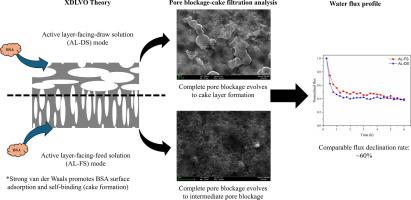类超滤正向渗透中蛋白质污垢的界面相互作用能和孔隙堵塞分析
IF 6.9
2区 材料科学
Q2 CHEMISTRY, PHYSICAL
引用次数: 0
摘要
蛋白质在具有反渗透(RO)样选择层的正向渗透(FO)膜上的污染已经被很好地理解,但在超滤(UF)样FO膜上的污染机制仍然很大程度上未被探索。与RO-like FO膜相比,UF-like FO膜具有均匀的孔径,上下表面之间的差异较小,假设无论膜取向如何,都表现出相似的污染行为。本研究研究了在活性面向层的进料溶液(AL-FS)和活性面向层的拉伸溶液(AL-DS)两种取向下,类uf - FO膜的污染动力学。通过聚合物溶液配方制备了最佳的uf样FO膜,并进行了6小时的牛血清白蛋白(BSA)过滤。采用孔堵塞-饼过滤模型分析了结垢机理,并通过扩展的Derjaguin-Landau-Verwey-Overbeek (XDLVO)理论评估了表面相互作用。在1 wt%的聚苯乙烯磺酸钠(PSS)拉伸溶液中,聚苯乙烯磺酸钠的水通量最高,为34.23 LMH,溶质通量最低,为17.32 gMH。两个方向上的通量下降(~ 60 %)相似,尽管AL-DS最初下降得更快。孔隙堵塞分析表明AL-DS模式下由孔隙堵塞过渡到饼状地层,AL-FS模式下为中间堵塞。表面相互作用分析表明,范德华力明显克服了共阴离子BSA和负膜表面之间的电荷排斥。在亲水性吸引作用下,BSA形成了高的γ - lw(43.90 mJ/m2)和正的ΔGCohΔGCoh (39.59mJ/m2)。这些发现为研究类uf - FO膜的污染机制提供了见解,为未来水处理应用的膜设计提供了信息。本文章由计算机程序翻译,如有差异,请以英文原文为准。


Interfacial interaction energy and pore blockage analysis of protein fouling in ultrafiltration-like forward osmosis
Protein fouling on forward osmosis (FO) membranes with reverse osmosis (RO)-like selective layers is well understood, yet the fouling mechanism in ultrafiltration (UF)-like FO membranes remains largely unexplored. UF-like FO membranes, characterized by uniform pore sizes with a less distinct difference between the top and bottom surfaces compared to RO-like FO membranes, are hypothesized to exhibit similar fouling behavior regardless of membrane orientations. This study investigates the fouling dynamics in UF-like FO membranes under both active layer-facing feed solution (AL-FS) and active layer-facing draw solution (AL-DS) orientations. Optimal UF-like FO membranes were fabricated by polymer solution formulation and subjected to 6-hour bovine serum albumin (BSA) filtration. Fouling mechanisms were analysed using the pore blockage-cake filtration model and surface interactions were assessed through extended Derjaguin–Landau–Verwey–Overbeek (XDLVO) theory. The membrane with 12 wt% PES (UF-12) demonstrated the highest water flux (34.23 LMH) and the lowest solute flux (17.32 gMH) under 1 wt% poly(sodium styrene sulfonate) (PSS) draw solution. Flux decline (∼60 %) was similar in both orientations, although AL-DS declined faster initially. Pore blockage analysis indicated a transition from pore blockage to cake formation in AL-DS mode and intermediate blocking in AL-FS mode. Surface interaction analysis revealed that van der Waals forces significantly overcame the charge repulsion between co-anionic BSA and the negatively charged membrane surface. BSA agglomeration, driven by hydrophilic attraction, was confirmed by a high (43.90 mJ/m2) and positive (39.59mJ/m2). These findings provide insights into fouling mechanisms in UF-like FO membranes, facilitating the development of antifouling membranes for water treatment applications.
求助全文
通过发布文献求助,成功后即可免费获取论文全文。
去求助
来源期刊

Applied Surface Science
工程技术-材料科学:膜
CiteScore
12.50
自引率
7.50%
发文量
3393
审稿时长
67 days
期刊介绍:
Applied Surface Science covers topics contributing to a better understanding of surfaces, interfaces, nanostructures and their applications. The journal is concerned with scientific research on the atomic and molecular level of material properties determined with specific surface analytical techniques and/or computational methods, as well as the processing of such structures.
 求助内容:
求助内容: 应助结果提醒方式:
应助结果提醒方式:


